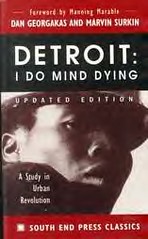Former editor used TSE to fight for social change
By John Williams
Posted: 12/12/07
Former South End editor in chief John Watson was at the forefront of a group of young revolutionary thinkers who, in the face of racism and a harsh political climate, made their mark on the Civil Rights Movement in Detroit.
Watson was the second editor of the university's student newspaper and changed the paper beyond its editorial policy to support political and social movements. According to a Detroit Free Press obituary, Watson died Nov. 16, 2001 at the age of 57.
Many of Watson's early brothers-in-arms said he was a brilliant revolutionary who made huge strides in the fight to end segregation. General Gordon Baker, a pioneer for worker's rights and the UAW, met Watson in 1961. Baker was a student at Highland Park Community College, and Watson was involved with some of the civil rights organizations.
"We crossed paths at a couple of demonstrations, and that's how I originally met him," Baker said. "John was a real activist, real skillful, real gifted guy, could do almost anything."
Watson was known among his peers as a gifted writer. He led study groups and even fixed complicated printing machines used in printing civil rights pamphlets.
He edited The Black Vanguard in 1965, which was a journal that was directed toward black workers, Baker said. Watson and Baker were roommates from 1964 to 1966, and Baker got to see Watson's talent at an earlier age, when he would write and edit leaflets and graphics.
"John had a lot of skills and experience," Baker said. "He had a lot of writing skills that he expressed real early, even before he had a newspaper as his medium."
Baker and Watson went on to write for The Inner City Voice, which stopped publishing when Watson moved on to become editor of The South End. Baker was the managing editor for The Inner City Voice but did not follow Watson to The South End.
"It wasn't necessary to do an Inner City Voice newspaper once we had access to The South End newspaper," Baker said.
Charles Simmons, a professor at Eastern Michigan University, knew Watson at the beginning of his days as an activist. He described Watson as a scholar who got his learning, not from academia, but from the social justice movements.
"We started a group called UHURU," Simmons said, "which was a civil rights, Black Nationalist organization for students, and John was one of the founding members."
UHURU, which in Swahili means "freedom," later transformed into The League of Revolutionary Black Workers. It was the spring board for many Detroit civil rights activists. According to Simmons, UHURU started in 1963, but some of its members had already been involved in the activism that going on in the South.
"There were students who came out of socialist backgrounds, out of civil rights background and also Black Nationalism," Simmons said. "These three tendencies merged to start a Detroit youth militancy of that era."
In 1963, the focus of these young students was on racism in Detroit, not on the university itself. According to Simmons, there were still segregation policies in the city of Detroit at that time in terms of employment, housing and police behavior. And the number of black students was very low at that time.
"We supported the decolonization struggles in Africa and opposition to the war in Vietnam and the various revolutions that were going on around the world," Simmons said. "We had a local and a global consciousness at that time."
According to Simmons, Watson was involved with the Young Socialists' Alliance and was a part of many of the youth social justice causes. Simmons said he had a very broad, global view of social justice and the revolutionary struggles that were taking place at that time.
"He was very young," Simmons said. "We were all young, I mean, we were all teenagers or maybe 20 or 21."
Simmons said that Watson was very studious and could apply the global and philosophical ideas locally. Many of these young revolutionaries worked in the factories as well as attending school.
Mike Hamlin, the general manager of The South End during Watson's time as editor, first met Watson in 1963 at the Detroit News. Hamlin was a truck driver and Watson was a jumper on the dock. Hamlin described Watson as a "genius" and a man "ahead of his time."
Hamlin said Watson was not an organizational person. Watson and Hamlin started at The South End in 1968 and were only enrolling in school, at first, to become active with the South End.
"Some people convinced him [Watson] to re-enroll at Wayne State and become the editor of The South End," Hamlin said. "He coaxed me into re-enrolling and coming down there to help him."
According to Hamlin, the climate at The South End during this era was that of resistance. The dean and local authorities showed "establishment hostility," Hamlin said. But there was also a great deal of support from students and faculty.
"We had a very progressive and strong faculty," Hamlin said, "And they upheld the notion of freedom of the press, and they held the university to that standard. And the university observed that standard."
According to Hamlin and Baker, Watson became very reclusive after his years as an activist in the 1960s. The whole community of people that were involved with the civil rights movement in Detroit lost touch with him. But his colleagues still have great respect for Watson.
"John Watson could do anything," Hamlin said. "John Watson could take the most complex machine that he'd never seen before and he could dismantle it and put it back together in a short time. I had the good fortune of working with two people with minds like that, John Watson and Ken Cockrel. They were amongst the brightest folks on the scene at that time."

No comments:
Post a Comment